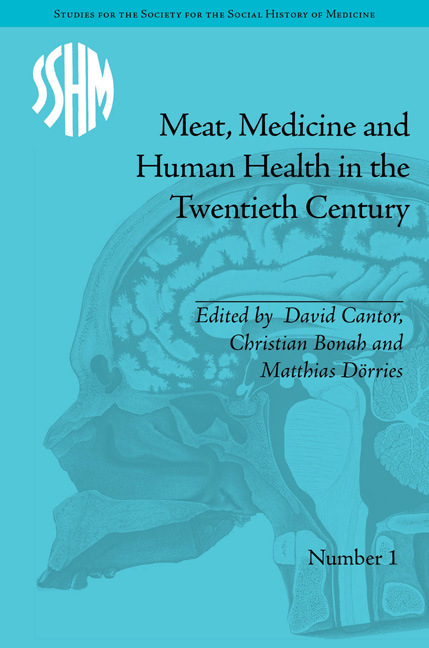Book contents
- Frontmatter
- CONTENTS
- Acknowledgements
- List of Contributors
- List of Figures and Tables
- Introduction
- Part 1 Meat and Therapeutics
- Part II Meat, Politics and Culture
- 4 What's Meatpacking got to do with Worker and Community Health?
- 5 Is Refrigerated Meat Healthy? Mexico Encounters the Chicago Meatpacking ‘Jungle’, c. 1910
- 6 Confused Messages: Meat, Civilization, and Cancer Education in the Early Twentieth Century
- 7 What's for Dinner? Science and the Ideology of Meat in Twentieth-Century US Culture
- 8 Vegetarianism, Meat and Life Reform in Early Twentieth-Century Germany and their Fate in the ‘Third Reich’
- Part III Meat, Risk and Regulation
- Notes
- Index
5 - Is Refrigerated Meat Healthy? Mexico Encounters the Chicago Meatpacking ‘Jungle’, c. 1910
from Part II - Meat, Politics and Culture
- Frontmatter
- CONTENTS
- Acknowledgements
- List of Contributors
- List of Figures and Tables
- Introduction
- Part 1 Meat and Therapeutics
- Part II Meat, Politics and Culture
- 4 What's Meatpacking got to do with Worker and Community Health?
- 5 Is Refrigerated Meat Healthy? Mexico Encounters the Chicago Meatpacking ‘Jungle’, c. 1910
- 6 Confused Messages: Meat, Civilization, and Cancer Education in the Early Twentieth Century
- 7 What's for Dinner? Science and the Ideology of Meat in Twentieth-Century US Culture
- 8 Vegetarianism, Meat and Life Reform in Early Twentieth-Century Germany and their Fate in the ‘Third Reich’
- Part III Meat, Risk and Regulation
- Notes
- Index
Summary
Attitudes about the healthfulness of foods are embedded in wider cultural beliefs. In the United States, except for a vegetarian counterculture, meat has generally been considered an essential part of a healthy diet. Economists have even attributed late nineteenth-century improvements in nutrition and public health largely to the greater availability of protein made possible by the technologies of mechanical refrigeration and industrial ranching. Admittedly, the feedlots and packing-houses which broadened access to meat have also produced serious public health scares, yet these have largely concerned the incidental contamination of processed meat, not its basic nature. Today, fears focus on E. coli infection and ‘mad cow’ syndrome, whereas a hundred years ago, adulteration resulted from industrial preservatives such as boracic acid or from accidents caused by low safety standards – to use Upton Sinclair's unsettling example of workers who fell into vats where ‘they would be overlooked for days, till all but the bones of them had gone out to the world as Durham's Pure Leaf Lard!’
When North American technologies were transferred to other cultures, however, they often raised more fundamental questions. For example, meat technologies transferred to Mexico at the beginning of the twentieth century generated suspicions about the healthfulness of meat and of the ways in which it was processed. Entrepreneurs from the meatpacking capital of Chicago attempted to convince the local population of the value of refrigerated meat in the first decade of the twentieth century.
- Type
- Chapter
- Information
- Meat, Medicine and Human Health in the Twentieth Century , pp. 95 - 110Publisher: Pickering & ChattoFirst published in: 2014



